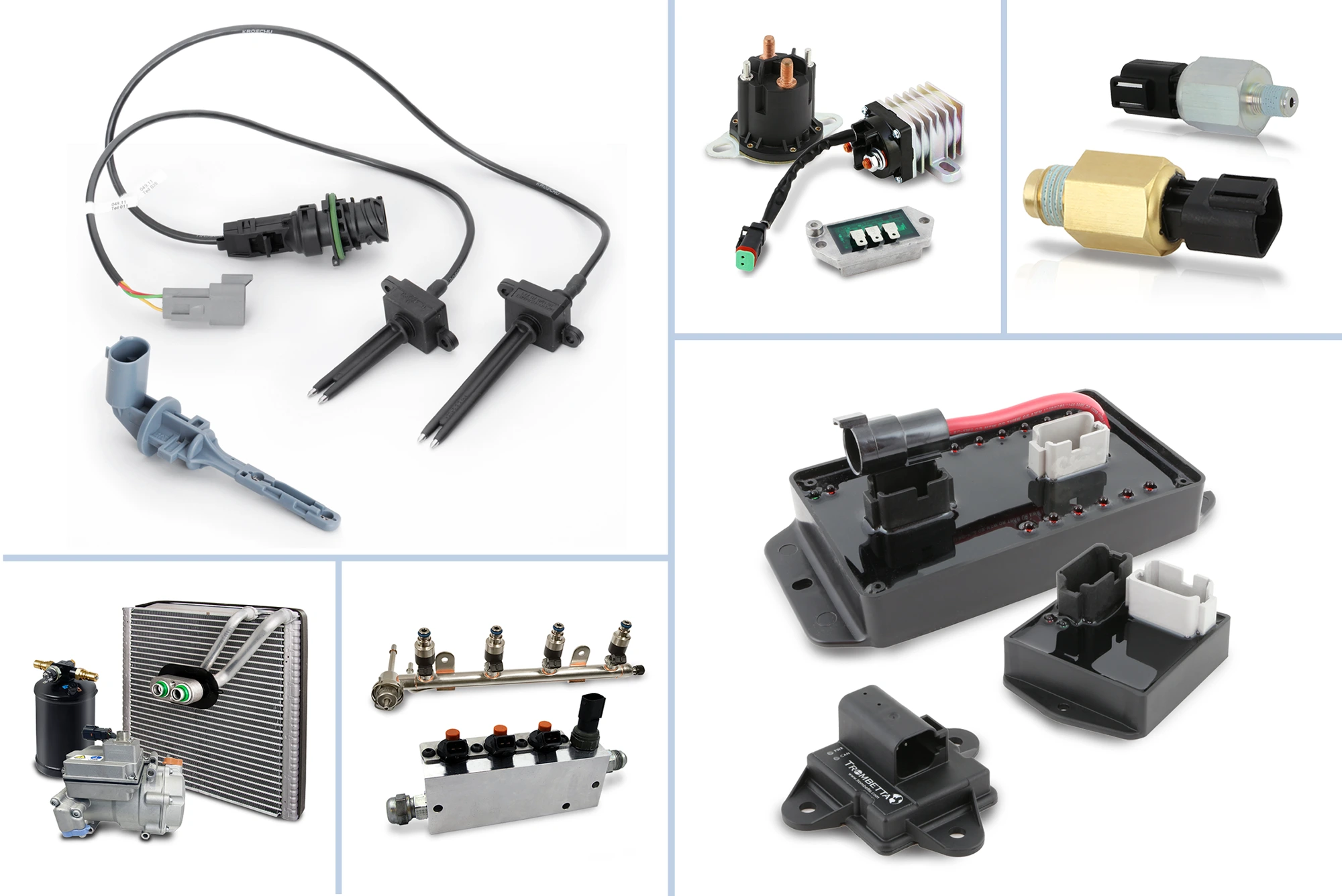September 09, 2022 / Training
A Closer Look: Blower Motor Resistor Operation
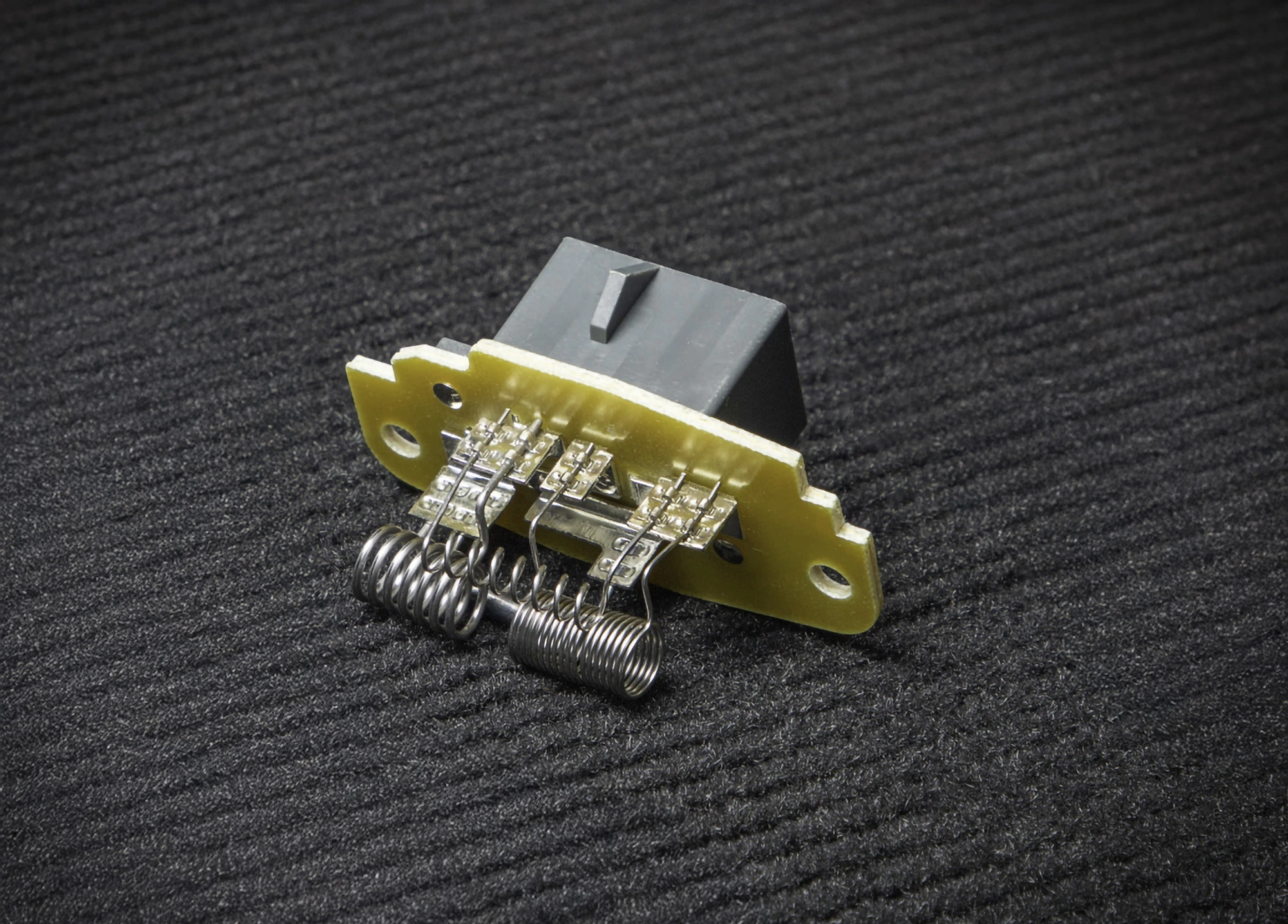
Blower Motor Resistor Operation
Blower Motor Resistors (BMR) control the electrical current flowing from the fan switch to the blower fan, which allows the motorist to set the fan at different speeds. The fan speed can be changed by switching the blower resistor resistance mechanically, using a rotating lever, or electronically, by the air conditioning system.
The blower motor resistor is responsible for controlling the blower motor speed. In the past, this was done by varying the voltage supplied to the blower motor. In later applications, the blower motor resistor is actually a solid-state module that sends a varied signal to the blower motor.
The traditional blower motor resistor is connected to ground, and wired in series with the blower motor assembly. Blower motor resistors have several resistors with different resistances. This controls the current that runs through the blower motor. Each fan speed selection is connected to one or more of the resistors in the blower resistor assembly. The change in resistance controls the current through the blower motor, which in turn limits the speed that the blower motor spins at. When high speed is requested, the blower motor resistor is bypassed and the blower motor ground circuit is connected directly to ground. This allows maximum current through the blower motor and maximum speed occurs.
Typical Blower Motor and Resistor Wiring
Reminder: Before you start testing, get the wiring diagrams and system operation for the blower motor and resistor for the vehicle application.
Testing Tips
-
Use service information to get the specific testing procedures and resistance values for ohm-testing the resistor itself
-
Verify power to blower motor
-
Verify the main ground to switch and resistor
-
Verify that the ground passes through each resistor pin to each pin at the switch and blower motor
-
With the resistor unplugged, verify that power makes it through the switch to resistor terminals
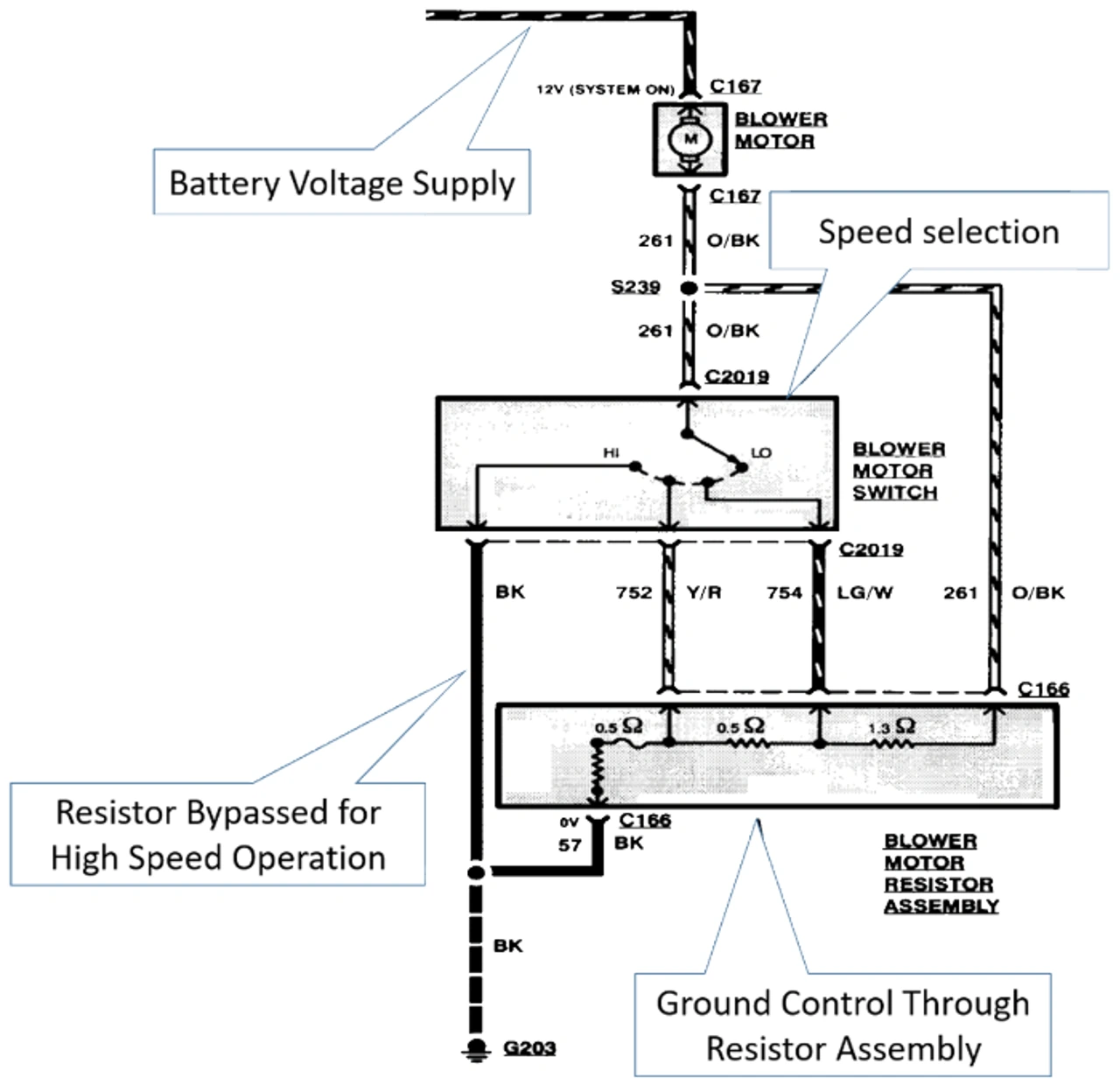
Power Tip
The blower motor resistor produces heat when in operation. This is why the resistors are located in the path of the blower motor airflow, as it provides cooling. If the blower motor is operated with the resistor assembly removed from its location, it will likely cause the blower motor resistor to fail. Excessive blower motor amperage due to a faulty blower motor or restricted cabin air filter should also be considered or possibly replaced to prevent repeat failures.

More recently, blower motor speeds are controlled using different methods. Most manufacturers have moved from simple resistor circuits to electronic control modules and solid-state controls.
The following guidelines are provided to help understand how blower motor speeds are controlled and how blower motor control circuits are tested. Refer to service information for the specific vehicle you are working on.
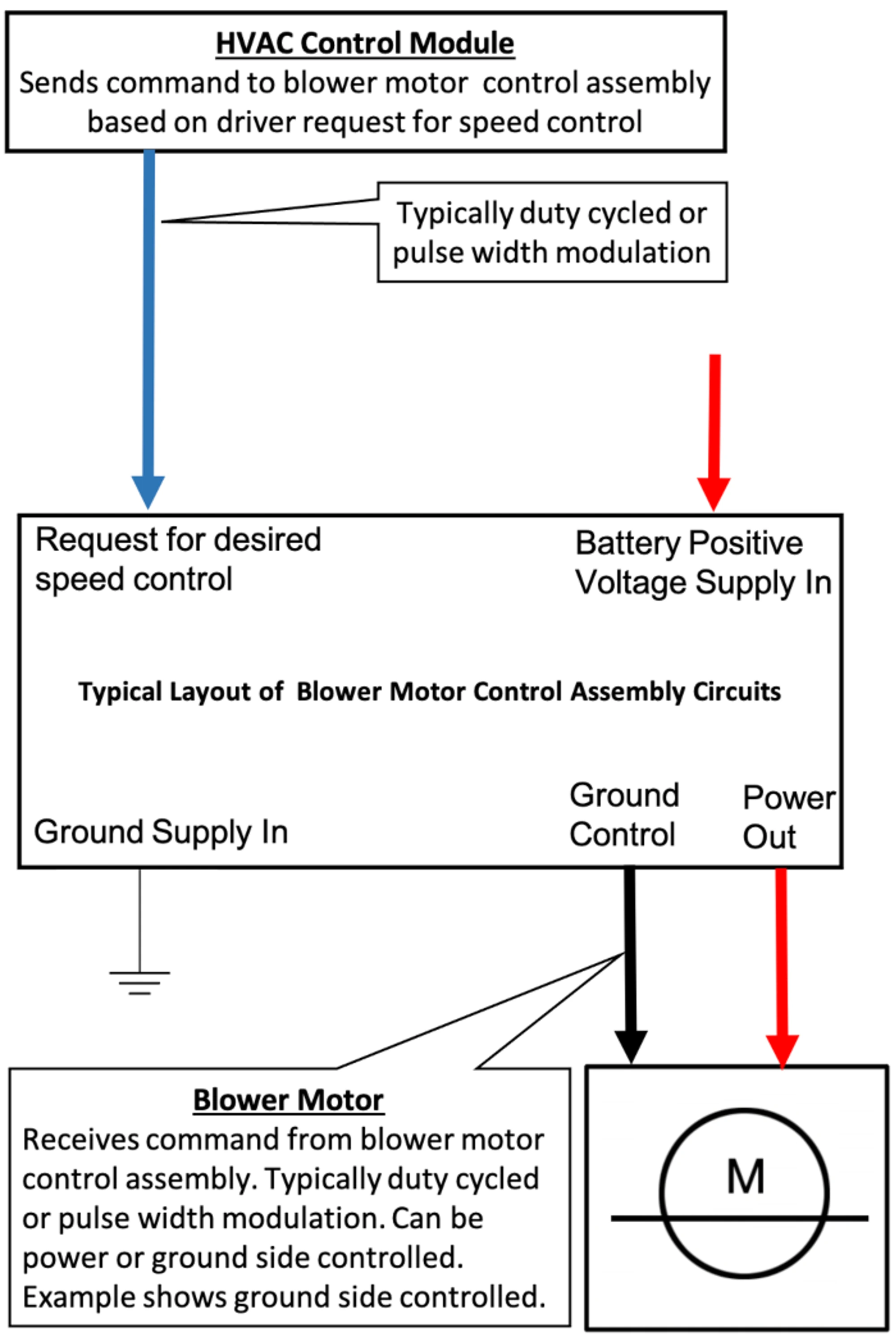
Use an inductive amp clamp to verify that the blower motor current draw is not excessive. Worn-out blower motors can cause excessive current. If the current is too high, replace the blower motor. This excessive amperage will cause the new blower motor control assembly to fail again. A guideline number for maximum amperage on high speed is approximately 15 to 20 amps. Specific vehicle application information should be verified.
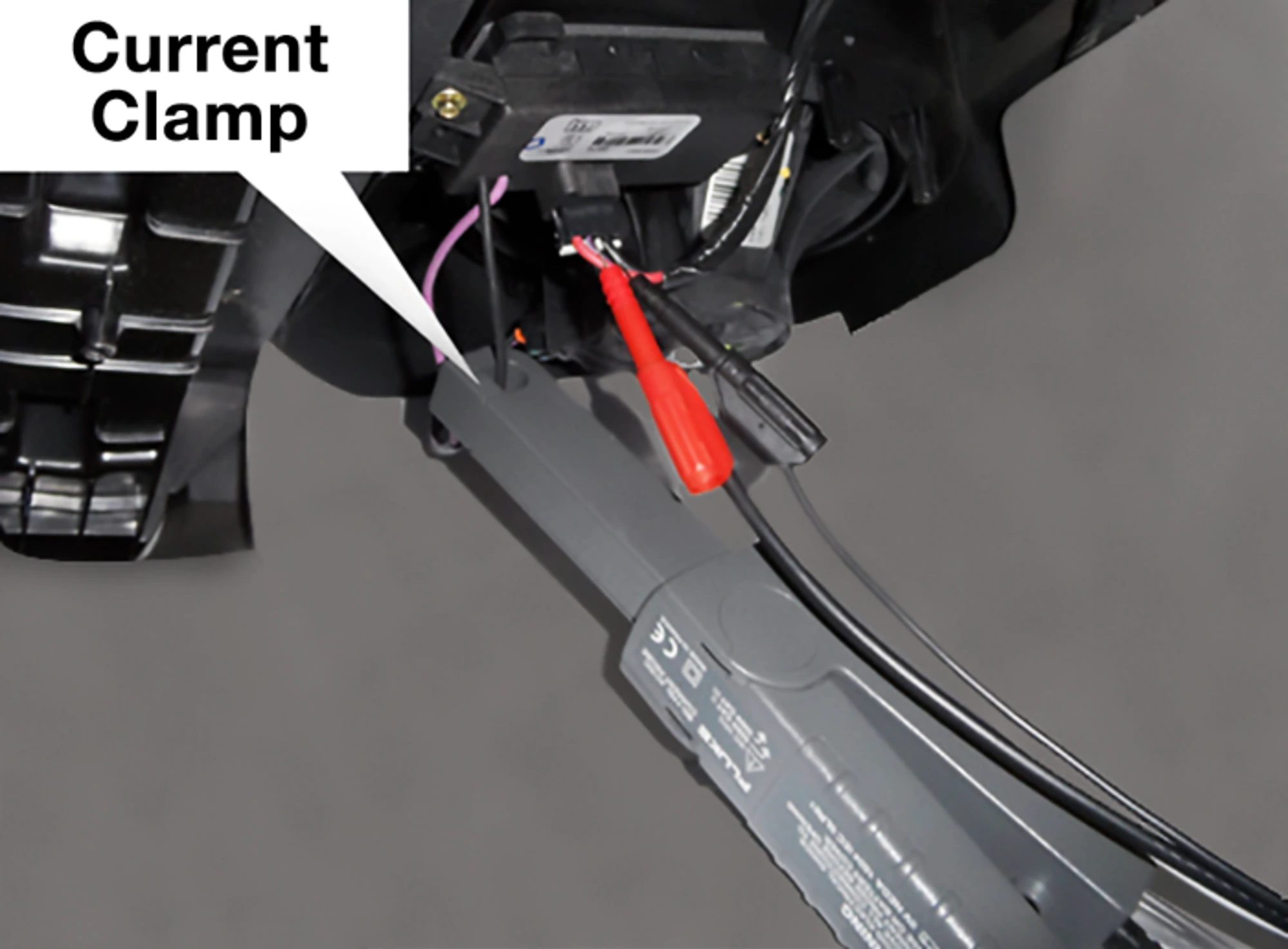
Power Tip
Possible repeat failure typically occurs during testing, when we are looking to verify if our diagnosis is correct. It happens when the currently installed or newly to-be-installed blower motor control assembly is operated without being completely installed in its proper location. The air flow created by the blower motor past the heat sink is used to help keep the electronic components inside of the blower control assembly from overheating. This failure may occur instantly or create a comeback sometime later.
It is equally important that there is airflow in the vehicle itself to keep the blower motor control assembly from overheating. Always inspect the cabin air filter.
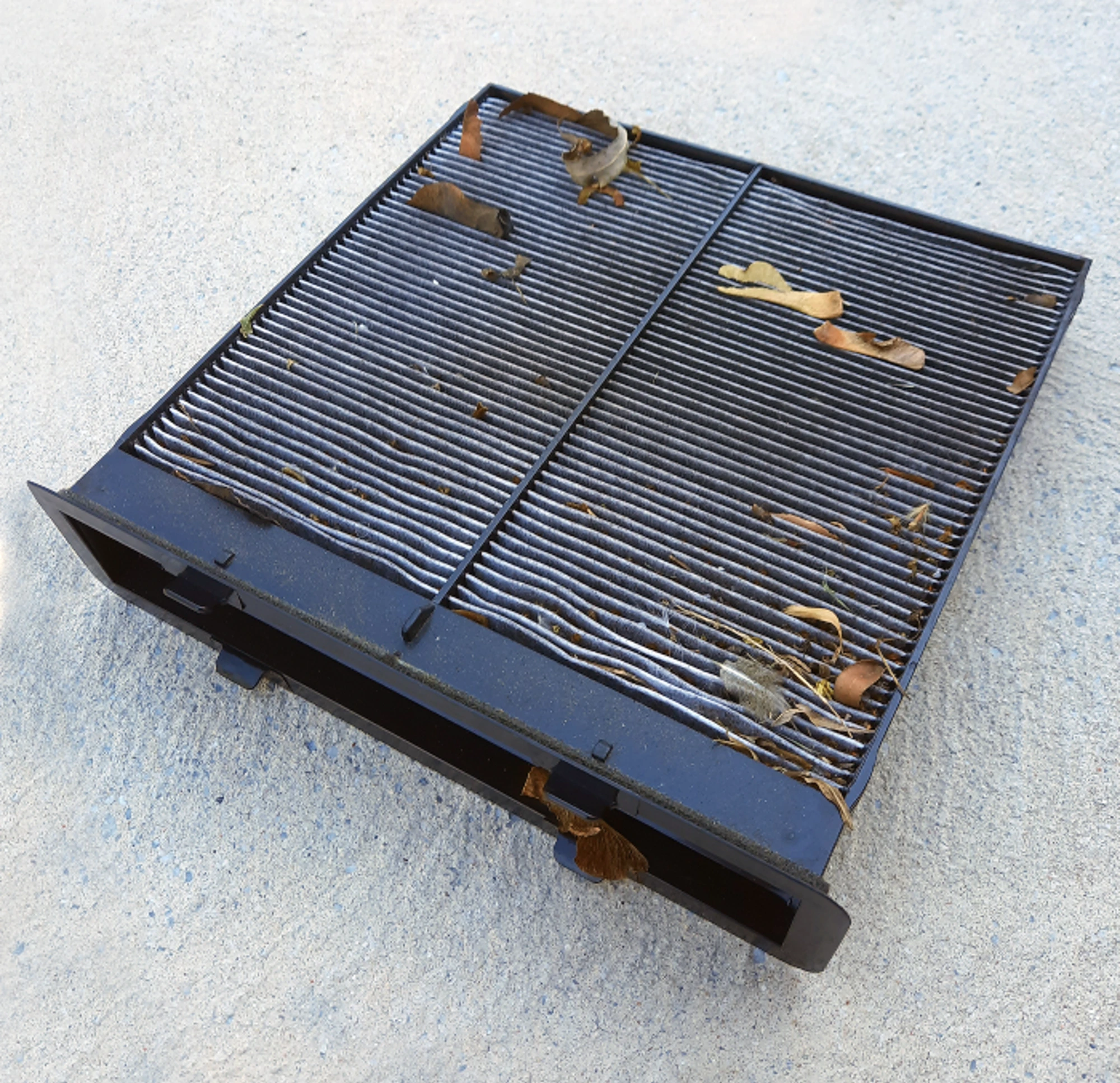
Power Tip
In addition to checking blower motor current draw, the mating connector should also be inspected for signs of damage caused by excess heat.
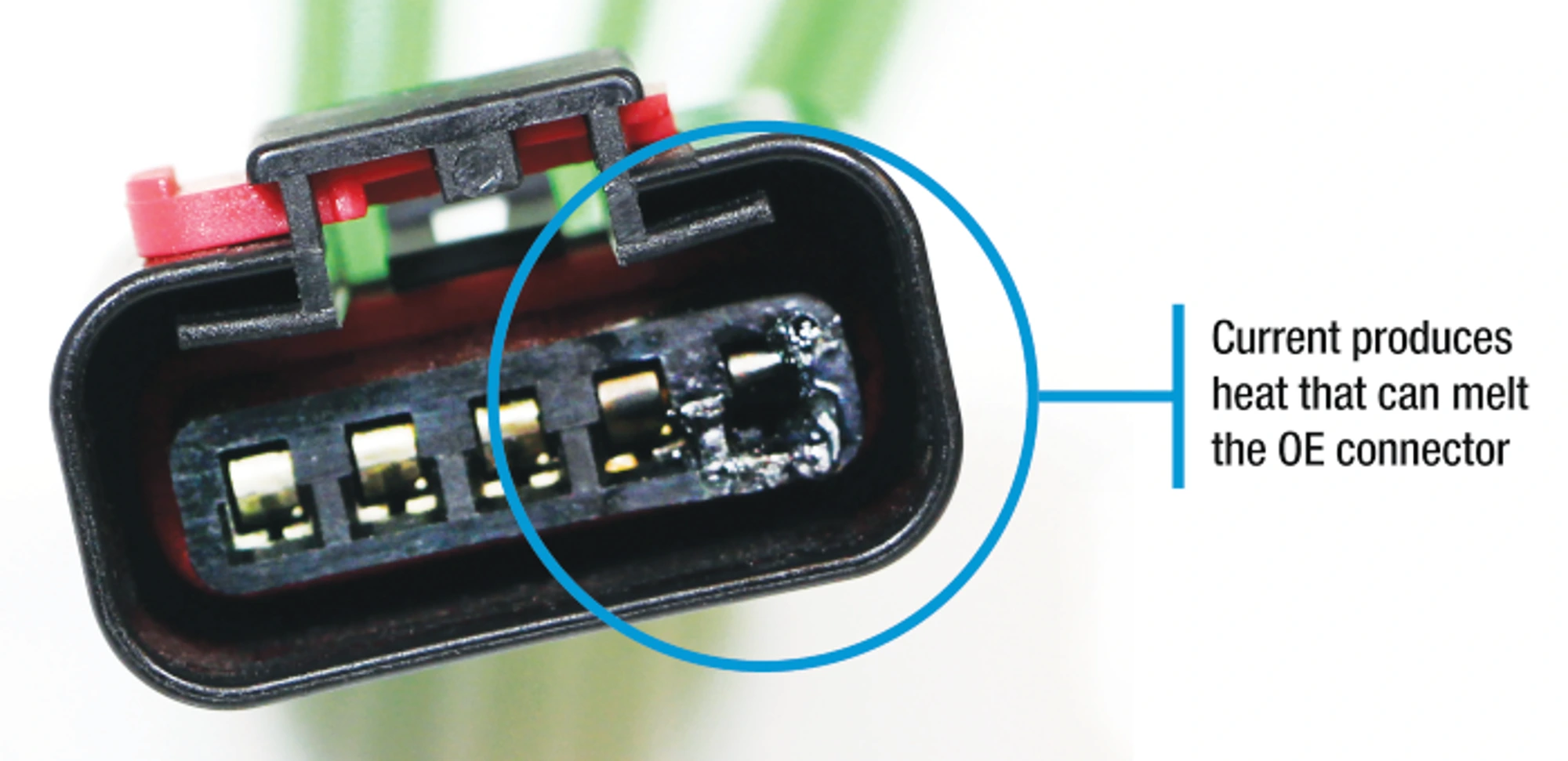
Due to technological advancements on today’s automotive heating and cooling systems, blower motor resistors have high amounts of current running through their connectors. As a result, the current produces heat that can melt the connector and resistor. Worn OE blower motors can create a demand for current that also damages the resistor or module. The excess current melts the wiring and plastic shroud, damaging the interface pins on the controller’s circuit board.
The Blue Streak® Solution: Standard® Blue Streak® Blower Motor Resistor Kits feature problem-solving high-temp connectors.
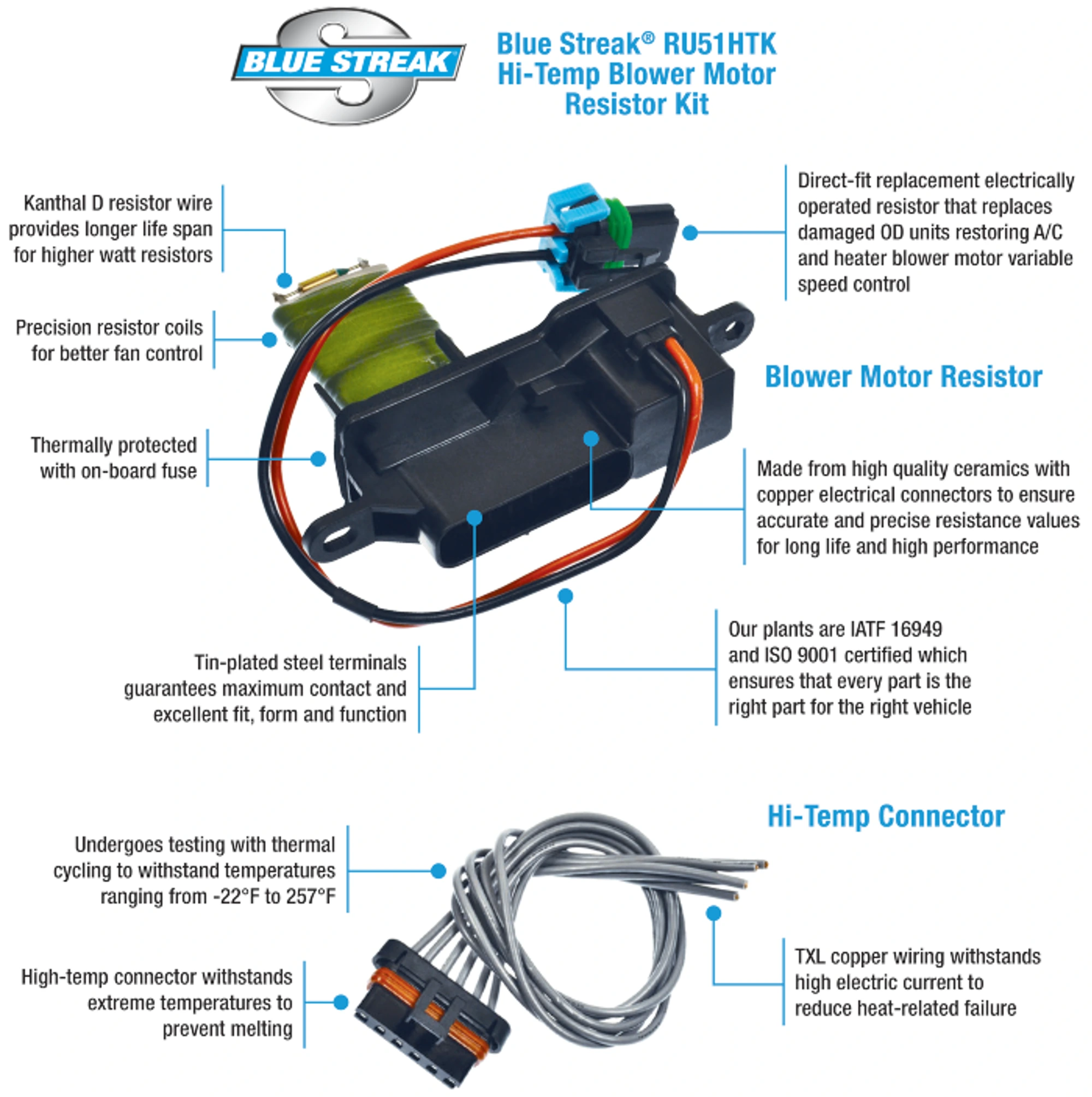
Standard® Blue Streak® premium Blower Motor Resistor Kits are a high-quality solution for melted connectors and blower motor resistors. Blue Streak® engineers improved on the OE design to create a connector that withstands the excessive heat and protects against future failure.
Blue Streak® connectors undergo thermal cycling testing to withstand extreme temperatures to prevent melting. Blue Streak® blower motor resistors are direct-fit replacements and engineered to withstand the high levels of current that can melt the resistor or connector.
Standard® and Blue Streak® – The Complete Blower Motor Resistor Program
Manufactured in IATF 16949-certified North American facilities, Standard® engineers sample-test every blower motor resistor for draw, resistance and RPM to precisely match the OE specs and meet or exceed the OE for durability. Performance is examined at all speeds, followed by 48-hour load tests. That’s how Standard® ensures their blower motor resistors will operate at peak performance and deliver a long service life under all operating conditions.
With more than 750 blower motor resistors in the line, Standard® BMRs use the highest-quality components that match the original for fit, form and function – while Blue Streak® hi-temp BMR kits feature problem-solving connectors engineered to withstand excessive heat and prevent melting common to the original.
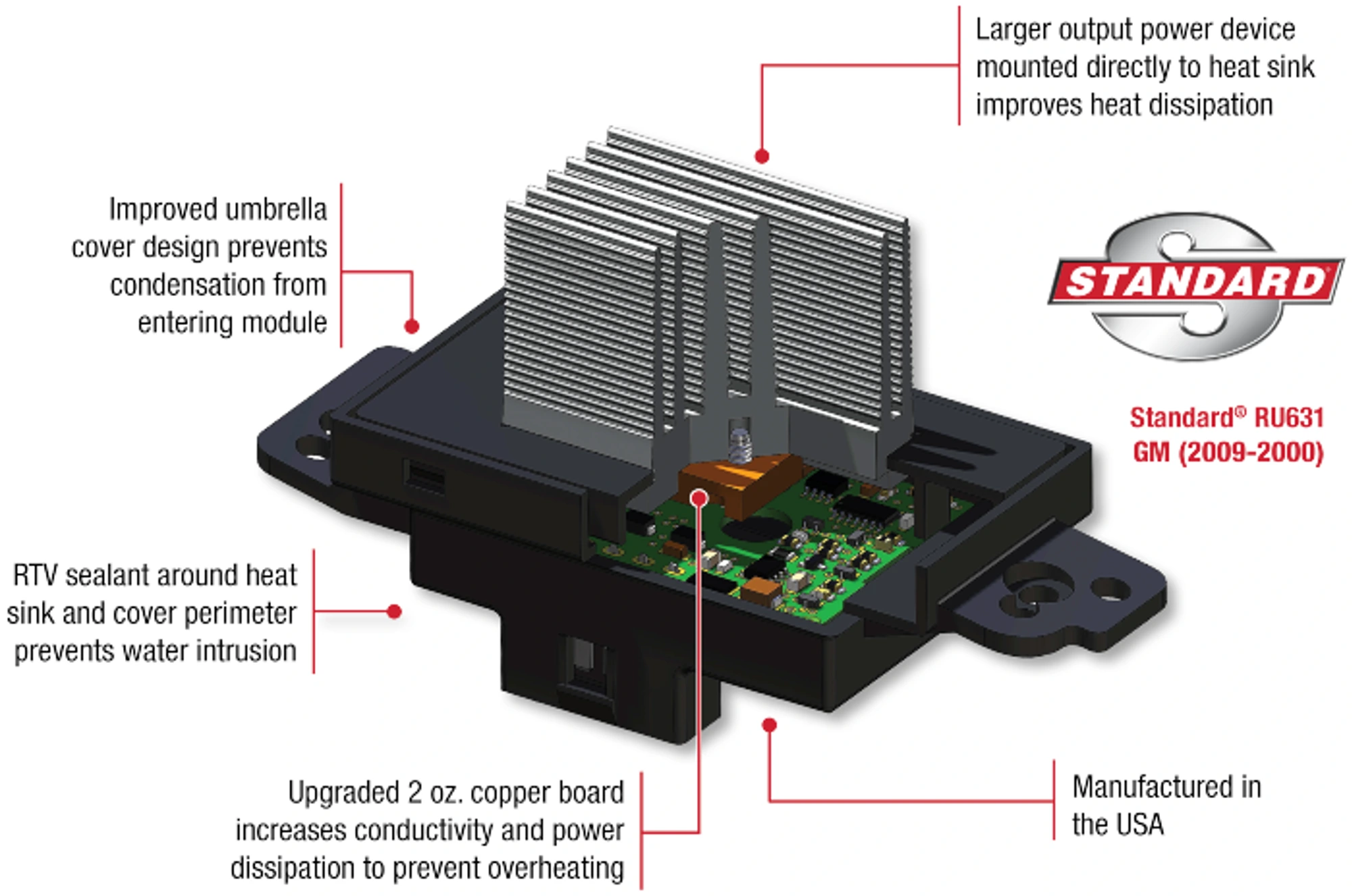
Next time a customer calls and asks for a blower motor resistor, help them avoid a repeat failure and recommend that they purchase a high-quality Standard® Blower Motor Resistor or a Blue Streak® Blower Motor Resistor Kit to do the job right.
Explore the Standard® advantage at BlueStreakBMRK.com.
Watch more Standard® videos: Blower Motor Replacement Tips and A Closer Look: Blue Streak Blower Motor Resistor Kits.
Next News
September 12, 2022 / Training
A Closer Look: Electronic Throttle Bodies and Control Systems
March 01, 2024 / Training
Why Pentastar Oil Filter Housings Fail
In service since 2011, the Chrysler Pentastar 3.6L engine has powered more than 10 million of the most popular vehicles on the road. These Pentastar engines are equipped with oil filter housings, which contain the oil filter, sensors, and a heat exchanger to help cool the oil. The oil filter housings on the Pentastar V6 engine have become known for their high failure rates. These failures have mistakenly been attributed the idea that the housings can warp due to heat, but this has been proven false. So, why do these units typically leak?
August 15, 2022 / Training
Variable Valve Timing (VVT) Repair Tips
Variable Valve Timing (VVT) or Variable Cam Timing (VCT) is common on most newer engines. These systems are designed to reduce emissions and maximize engine performance and fuel economy. Here's some background on VVT and a few tips for dealing with issues that come up.
August 22, 2022 / Training
Variable Valve Timing (VVT) Operation
Variable Valve Timing (VVT) systems help reduce emissions and maximize engine performance and fuel economy. The VVT Solenoid (Oil Control Valve) meters the oil flow to control the actuation of the VVT Sprocket (Actuator or Phaser). The VVT Sprocket mechanically shifts the position of the camshaft. Here are a few tips for testing.
August 08, 2022 / Training
Turbocharger Diagnosis Tips
Turbocharged engines are becoming more popular, as vehicle manufacturers look to increase fuel efficiency, maintain performance and reduce emissions. Symptoms of a malfunctioning turbocharger include loss of power, excess smoke, high fuel consumption, overheating, high exhaust temperature and oil leaks from the turbo. Here are a few important diagnostic and repair tips to keep in mind.
August 12, 2022 / Training
Tire Pressure Monitoring System (TPMS) Repair Tips
The Tire Pressure Monitoring System (TPMS) is a safety device that measures, identifies and warns you when one or more of your tires is significantly under-inflated. Standard® and Intermotor® are committed to helping technicians with TPMS repairs, whether it’s offering OE-Match TPMS sensors or providing repair tips from our team of ASE-certified master technicians. Here are a few TPMS repair tips.
August 05, 2022 / Training
Mass Air Flow (MAF) Sensor FAQs
The Mass Air Flow (MAF) sensor is a key component of the engine’s fueling strategy. It is crucial that the MAF sensor reports with 100% accuracy to ensure peak performance, fuel economy and reduced emissions. Here are some helpful tips such as how and when to replace them and steps to extend their longevity.
August 19, 2022 / Training
Ignition Coil Operation
Coil-on-plug assemblies are designed to convert a low voltage (primary side) to a high voltage (secondary side) to fire the spark plugs. They perform the functions of both the ignition coil, which creates the spark energy, and the spark plug wire set, which delivers the high-voltage energy to the spark plug. Today's coil-on-plug assemblies come in a variety of physical and wiring configurations.
August 01, 2022 / Training
Diesel Engine Repair Tips
Diesel Engines have become more popular thanks to a steady string of advancements. New engine designs, noise and vibration-damping technologies, and improvements like electronic engine control have spawned a new generation of engines that are more powerful and fuel efficient than similar-size gasoline engines. Learn more about today's diesel engines with these repair tips from our team of ASE-certified master technicians.
January 01, 2023 / Training
A Closer Look: Variable Valve Timing
In an effort to increase fuel efficiency and elevate performance across today’s vehicles, nearly every manufacturer has equipped new vehicles with Variable Valve Timing (VVT) technology, also known as Variable Cam Timing (VCT).
January 05, 2024 / Training
A Closer Look: Turbochargers
Turbocharger Opportunities: In an effort to increase fuel efficiency, maintain performance, and reduce emissions, vehicle manufacturers are adding turbocharged engines to their lineups at a significant rate. Over the next five years, the turbo service market will continue to experience substantial growth.
September 19, 2022 / Training
A Closer Look: Turbocharger Operation and Installation
Turbochargers consist of just three major internal components: the turbine, the compressor and the bearing system that supports the turbine shaft. In an effort to increase fuel efficiency, maintain performance and reduce emissions, vehicle manufacturers are adding turbocharged engines to their lineups at a significant rate.
September 16, 2022 / Training
A Closer Look: Tire Pressure Monitoring Systems (TPMS) Operation
The Tire Pressure Monitoring Systems (TPMS) is a valid safety device that has been mandated for years. TPMS introduced a lot of new terminology – initiate, program, activate, clone, protocol and relearn. This safety system, a prime service opportunity, warns drivers of issues with their tires and protects motorists from potential danger.
January 15, 2024 / Training
A Closer Look: Servicing Electric and Hybrid Vehicles
Hybrid vehicles have been sold in the U.S. for over 20 years. As hybrids continue to grow in popularity, and as fully electric vehicles have entered the market in the past several years, they have brought with them numerous service opportunities for aftermarket repair facilities. Whether shops dive in and get involved with replacing batteries, inverters, or other high-voltage components, or they stick to light-duty servicing, there is plenty of work to go around.
January 08, 2024 / Training
A Closer Look: Ignition Coils
Engine misfires, rough idle, a decrease in power under acceleration, poor fuel economy, and a check engine light are all signs of an ignition coil that has failed. OE coils are known for their high failure rates. Read along for more information on ignition coils, how to diagnose a failed one, and why an original equipment manufacturer’s coil may not be the best replacement choice.
January 12, 2024 / Training
A Closer Look: Gasoline Direct Injection (GDI)
Gasoline direct injection (GDI) is used on most new vehicles and requires a different approach to diagnosis and service. GDI technology has been an integral part of helping to improve fuel economy while reducing emissions and can be found in more than half of the U.S. fleet. In fact, the use of GDI engines has grown by over 600% since 2010. This means that in the next five years, 42 million more vehicles with GDI will enter the Aftermarket “Sweet Spot” of 6-12 years old, during which their injectors and related parts may need to be serviced or replaced. While GDI systems have proved effective, these systems encounter specific failures and require an understanding of how they work and how to test them when they set a code.
January 26, 2024 / Training
A Closer Look: Emissions
The Check Engine Light (CEL) is arguably one of the most effective yet underappreciated advancements in reducing vehicle emissions. Following the introduction of On-Board Diagnostics II (OBD II), the CEL is illuminated continuously if an on-board system monitor has failed a specified number of times and is negatively affecting emissions. If a catalyst-damaging event, such as a misfire, occurs, the CEL will flash. In today’s world of electric vehicles, hybrids, and partial zero-emission vehicles, many people forget that simply keeping their internal combustion engine (ICE)-powered vehicle operating as designed will help in reducing emissions.
January 29, 2024 / Training
A Closer Look: Electronic Throttle Bodies
A shop’s reputation is affected by things like accuracy of diagnosis, quality of the repair, and friendly service. Equally as important is the quality of the parts installed. If the shop does everything right, and the part fails, the customer will ultimately be upset with the shop. When a new part fails, the customer is inconvenienced again, and begins to lose faith with the shop that performed the work. This ultimately begs the question–why take a chance with inferior parts?
January 19, 2024 / Training
A Closer Look: Advanced Driver Assist Systems (ADAS)
Advanced Driver Assist Systems have created quite a buzz over the last several years. New business opportunities continuously arise, including a new segment of mobile technicians focusing on ADAS calibrations. While ADAS may still seem relatively new, automotive service professionals have actually been servicing Driver Assist Systems for decades. Systems like power steering, power brakes, and cruise control have been assisting motorists for many years. What is different with ADAS is that there are now input devices to understand what the driver’s intent is and alert the driver to potential dangers, rather than relying solely on the driver’s sight and sound.
January 22, 2024 / Training
A Closer Look: ABS Sensors
Anti-lock Braking Systems are intended to do exactly as the name portrays – prevent a vehicle’s wheels from locking up during a braking event. If any of the wheels lock up, the driver has less control of the vehicle and is more prone to an accident. By releasing some brake pressure to the locked-up wheel, the stopping distance will be increased, but the driver will be able to maintain control to hopefully avoid a collision. Prior to ABS, drivers were taught to pump the brake pedal when attempting to stop suddenly, or when stopping on gravel, ice, or loose pavement. Now, the ABS system does that for them.
